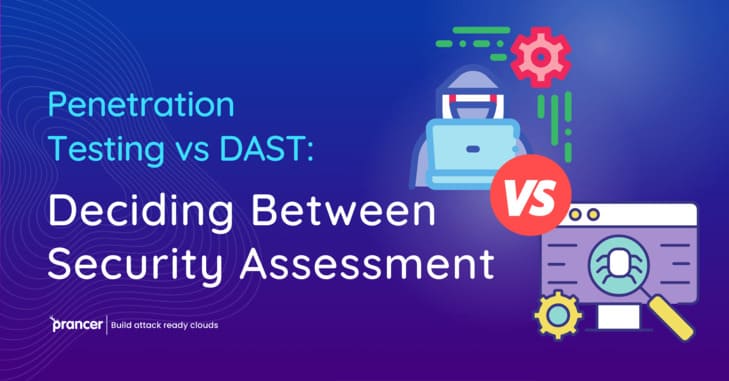

In a world where cybersecurity challenges continuously grow in complexity and dynamism, cybersecurity assessments with a robust security approach are detrimental for all industries. Among the various approaches available, the debate between Penetration Testing vs DAST becomes pertinent. Automated penetration testing is a significant instrument in the defense of digital resources, combining the rigour of manual testing with the efficiency of automation.
Prancer’s services based on automated penetration testing are a game-changer for the security assessment. It empowers the test with the automation that is quick ramping, effective and accurate. Automated penetration testing tools implement the techniques of mimicking comprehensive cyber-attack scenarios by means of repeated jobs and using cutting-edge algorithms. Such tools have the ability to find flaws in networks, systems, and applications. Increased velocity of the assessment process and assurance of all the security controls in place is achieved through this approach. Organizations can be able to pinpoint and deal with possible problem areas hence, acting beforehand.
We are expert in Prancer at giving individualized solutions for the automated penetration testing that are customized to conform with the needs of the client’s situations. Automation testing platform of ours deploys up-to-date technological innovations and approach to integrate with the organizations’ systems, producing meaningful intelligence designed to fortify their security walls. Using the Machine Learning for penetration testing purposes, organizations can have a full view of their security posture, disclose unexpected weaknesses, and reduce the risk level using the remediation approaches in order to achieve the required security.
To take a wide scan, automated penetration testing involves a complete manufacture of security analysis. On the other hand, Dynamic Application Security Testing (DAST) specializes in protecting web applications monitoring. DAST tools analyse web applications in their operation mode, which in turn mimics actual attacks that appear when the application is online to identify numerous security breaches like SQL injection, cross-site scripting, and lesser authentication mechanisms. DAST works by emulating the behavior of an attacker and it does so dynamically. This allows organizations to detect and remove defects in the application layer, which decreases the chance of exploiting the system by an evil person.
Prancer’s DAST tools work nicely with our automated pentesting products and all together present an enterprise-class end-to-end approach to the protection of digital assets. We equip your organization with an all-in-one DAST solution which leverages automated scanning features as well as in-depth analysis capabilities, thus finding web application security vulnerabilities in a fast manner. Integrating DAST into security assessment strategy of the organization can help the organization to make sure that web applications are intact and resilience against different security threats ensuring their continuous service to the customers and preventing leakage of sensitive data.
While choosing between Penetration Testing vs DAST, organizations need to base their decision on many factors such as their security objectives, technical capabilities and limitations, and budget allocations. Automated penetration testing offers a comprehensive organizational security overview which is ideal for those that require a holistic outlook on their security, whereas DAST specializes in web layer security, catering to organizations that want to maintain the security of their online surf.
We also know that every organization differs and therefore create specific personalized services that take into account the aims and goals of our clients. Unlike any of the other firms, we offer clients with the choice of SQL injection, automated penetration testing, or maybe all of them through our experts team of cybersecurity who work closely with clients in tailoring individual security assessment plans that can appropriately address security concerns. It’s with us, Prancer that becomes your trusted security partner. So you can confidently embark on the digital terrain reassured that protection against ever-growing cybersecurity risks is intact.
The place penetration testing service plays in current cybersecurity environment is very critical, this is because an organization can use the approach to be proactive in discovering and responding to the security challenges. Incorporation of automation tools will help organizations do a thorough analytical security evaluation quicker, thus saving time and resources required to carry out a manual test. On top, autimatized penetration testing is by helping organizations to know when vulnerabilities are emerging, and to stay ahead in a brittle security management scenario.
Dynamic Application Security Testing (DAST) is an of security measures that add numerous protection layers against the ever-growing cyber threats. DAST will enable the institutes to detect data security risks existing in websites such as SQL injection and cross-site scripting, before bad actors use them to compromise security. Organizations can withhold intruders from having a chance to intrude their web applications and, thus, vast amounts of sensible data and customer trust when they add DAST into their security assessment approach.
Organizations should access their security goal establishments carefully and determine whether automated penetration testing or DAST would operate better. Although automated penetration testing provides significantly more extensive and thorough assessment of the security structure surrounding networks, systems, and applications, DAST only focuses on web-related application security. While organizations need to take into account of their industry regulations, budget constraints and technical requirements when deciding which technique is suitable for them, they should also not forget about other factors such as accuracy, security, and sustainability.
When dealing with an ever-changing and volatile cybersecurity scenario, counterattacks should not only be reactive ones but also should be proactive ones to seal away any breaches in digital assets from emerging threats. Automatic penetration testing and DAST provide two methods that are not the same, each of which rests upon the standpoint of the strength of its application. Through mastering the subtlety of these techniques and implementations, combined with the tech wizardry of trusted cybersecurity specialists like Prancer, businesses can strengthen their security stance, protect themselves against intruding risks, and stay immune from changing cyber threats.
